News and Updates
New Mexico: Alfalfa Weevil Alert 2022
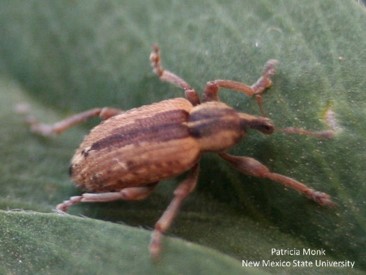
Adult alfalfa weevil (Photo: Patricia Monk)
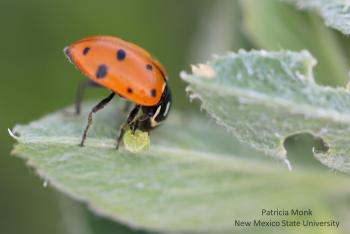
Adult ladybug feeding on an alfalfa weevil larva (Photo: Patricia Monk)
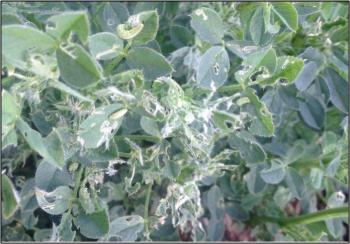
Alfalfa weevil damage and larvae (Photo Mark Marsalis)
It’s time to scout for alfalfa weevil. Consultants in many areas of New Mexico have been seeing them consistently in the last few weeks. Some fields have not produced many weevils yet and may not have a bad year, but other locations are getting near threshold numbers and starting to see damage, which suggests it could be a difficult year.
Weevil populations have been increasing statewide particularly the last 5 years so they warrant close attention. Don't wait for damage to be obvious from the pickup. You need to know how many larvae are in the field before they are large enough to do much damage, allowing time to plan for treatment. Not all fields will have significant losses. The NMSU ASC fields in Artesia, for example, have not been treated for about 20 years, as there are high populations of beneficials, with two species of parasitoids and numerous species of predators.
In the Mesilla Valley, two species of parasitoids largely kept alfalfa weevil larvae below threshold for about 20 years. However, growers in recent years began seeing more damage. The Pecos valley has had variable levels of control with only one species of parasitoid in most fields rather than two. The upper Rio Grande Valley has only one parasitoid and numbers of both that parasitoid and predators are generally low. Every area is different and fields within areas can be very different so it’s critical to get a net and to sample for weevil larvae.
Since some fields have high populations of beneficials like ladybugs, nabids and crab spiders growers may be wondering how to take this into account. Unfortunately, there are no firm guidelines on how to predict how well beneficials will control weevils. If you are seeing, for example, 1 beneficial per 3-5 weevils, particularly if they are small weevils, those beneficials might be able to keep weevils in check. Consider holding off on treatment then recheck or alternatively use Steward, which is reportedly softer on beneficials, if an insecticide is needed. Conserving beneficials will help avoid the need for additional treatments. Steward is expensive so the primary reasons to use it instead of a pyrethroid are to conserve beneficials to help avoid additional treatments or because there is resistance to pyrethroids and that is the only treatment option.
Cutting hay is also an option to control weevils. Sunlight, high temperatures and low relative humidity cause high mortality to virtually all insects in New Mexico. This can be a difficult decision if hay is not quite ready for cutting but close monitoring of weevil and beneficial populations will help with this decision. If weevil numbers are high, larvae are getting relatively large and there are few beneficials, there is not much time. Conversely, if you find mostly very small weevil larvae and quite a few beneficials you might have time to accumulate more growth before cutting and avoid a costly application.
Effective management strategies and more photos can be found in the NMSU Extension Publication Guide A-338: Alfalfa Weevil Control Guide. But keep in mind we will be changing thresholds to be more aggressive, likely about 5 weevils per sweep.
Insecticides
Recent studies in Arizona suggest we should likely be more aggressive with weevils, treating at a lower threshold. We will likely change to a threshold of 5 weevils per sweep (or less depending on hay price). Sampling routinely is key to avoiding damage and spending money on treatments that don't produce higher yields. Sampling regularly, certainly, once damage is noted, is critical to avoid revenge treatments, i.e., treating a field that is damaged but no longer has threshold numbers of larvae.
The purpose of insecticides is to kill insect pests that are feeding when the application goes out. Do not assume there are still pests because there is damage or base treatment decisions on old numbers if there have been delays. Situations change fast and weevils may have matured or been taken out by beneficials. If there is damage but few pests left in the field, an insecticide application will not result in higher yields. It is tempting to treat, to take care of business, but at that point, it would be wiser to save the funds for something that will provide a better return.
Steward is recommended by many consultants. It has quick knock down, a short cutting restriction and is softer on beneficials than the other insecticide options. Although the residual activity might be a bit shorter than some other products, the impact from one application along with conservation of beneficials might allow natural enemies to keep weevils below threshold after one application. In the Pecos Valley, technical representatives and consultants recommend Steward 6 oz/A plus Silken 4 oz /A or some other organosilicone surfactant using at least 5 gallons per acre. With chemigation, use 0.1-0.2 inches of water/Acre. A surfactant is not needed with chemigation. In areas where there are fewer beneficials, consultants often choose a higher rate. The Steward label gives a range of 6.7 to 11.3 oz/ac for alfalfa weevil larvae control.
Some areas of New Mexico are having very high resistance to pyrethroids but in other areas, there is still some activity. If beneficial populations are very low, Steward may not be worth the additional cost as long as pyrethroids are providing adequate control. Check with local suppliers, consultants and extension agents who see the results of insecticide treatments in their areas routinely.
If beneficials are abundant, consider just using Steward. If a second treatment is necessary, you can go back 7-10 days later with 5.1 oz of Steward and 4 oz of Silken. Keep in mind that adults do not cause much damage directly so in targeting adults you would be primarily trying to suppress future populations rather than avoiding much direct damage.
Organic Growers can suppress weevil populations with Entrust 2-4 oz/A, which is a Dow Agrosciences Spinosad product.
Contacts: Jane Pierce (ASC Artesia), Carol Sutherland (NMDA/NMSU Las Cruces), Mark Marsalis (ASC Los Lunas), Leonard Lauriault (ASC Tucumcari), Robert Flynn (ASC, Artesia) and your local County Cooperative Extension agent.
Pink Bollworm Eradicated
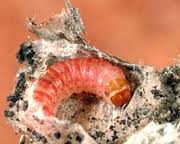
Pink Bollworm Larva
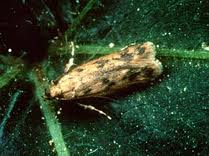
Pink Bollworm Adult Moth
On October 19, 2018, the USDA declared pink bollworm eradicated from the United States. This was accomplished by many years of cooperation from growers, industry leaders and researchers across the US. New Mexico also played a part in this success.
The third year of sampling pink bollworm in Southeastern New Mexico has once again resulted in zero pink bollworm moth captures. This combined with continued zero captures in Southwestern New Mexico indicates that pink bollworm is likely eradicated from New Mexico. The last three years data has been submitted for publication to support designation as a generally free from pink bollworm designation.
In 2010 and 2011 the NMSU Agricultural Science Center in Artesia trapped pink bollworm moths in southeastern New Mexico and West Texas in a joint program with Texas A & M University and USDA/APHIS. New Mexico traps were placed both on commercial farms and in trap lines that ran from Chaves County, New Mexico south into Texas and from Lea County to Gaines County, Texas. All New Mexico has zero captures in 2010 and 2011. The boll weevil eradication program trapped pink bollworm in 2012 and again did not capture any pink bollworm moths in New Mexico.
Biological Control of Alfalfa Weevil - Saves NM Growers $1 Million per Year
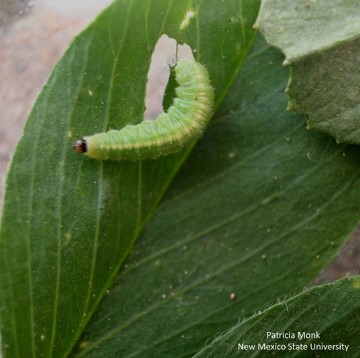
Alfalfa Weevil Larva
In the 1980's USDA entomologists released three parasitoids in New Mexico to control alfalfa weevil. These releases followed up on extremely high success rates of these parasitoids in controlling alfalfa weevil in other parts of the US. Beginning in 2002 the NMSU Agricultural Science Center in Artesia began evaluating the effectiveness of these parasitoids in New Mexico. Obvious questions were, did the released parasitoids become successfully established and how well were they controlling alfalfa weevil? Dona Ana County had two parasitoids that had become well established Bathyplectes spp. and Oomyzus incertus. Alfalfa weevil is generally well controlled in that area and growers do not regularly make insecticide applications to control alfalfa weevil.
The rest of New Mexico had only one parasitoid established and parasitization rates were highly variable even within small geographic areas. The Pecos Valley for example has 0-92% parasitized weevils in commercial fields. Historically at least two parasitoids are needed for good control of alfalfa weevil so NMSU-ASC/Artesia has been working to establish the second parasitoid, O. incertus in other areas of New Mexico. Field insectaries have been established and releases have been made every year on commercial farms. Oomyzus incertus is progressively becoming more well established and controlling the higher numbers of alfalfa weevil with over 20% control just by O. incretus at the research farm in Artesia. This is close to the 35% control in the Mesilla Valley by this parasitoid which works in conjunction with Bathypletes to typically provide over 80% control. O. incertus has also been migrating from release sites and has been detected 22 miles from the primary field insectary in Artesia.
Glandless Cotton in Southeastern New Mexico
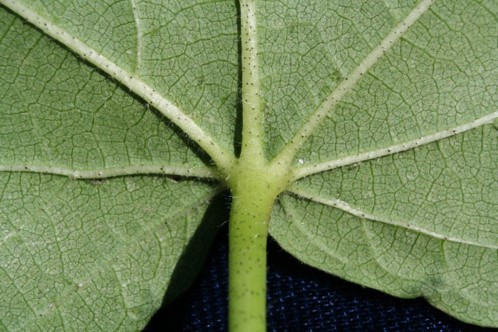
Glanded Cotton Leaf
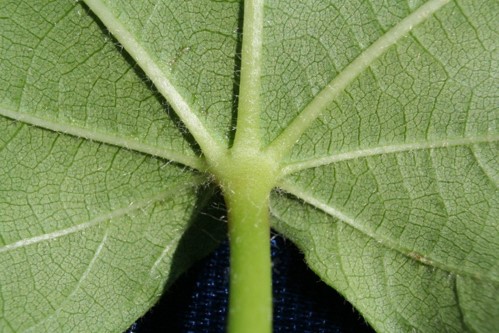
Glandless Cotton Leaf
Glandless cotton is an exciting product because the see is not toxic and can be used in food products for people and for high value animal feed such as shrimp foot. The potential value of glandless cotton seed, in fact would be higher than the cotton fiber. Conventional cotton has gossypol which is toxic to most animals. While glandless cotton has been available for some time, it has not been commercially available due to high loss from insects since gossypol also protects cotton from insect losses. Previous trials, however, were conducted in areas of very high insect pressure. Lower insect pressure in parts of New Mexico and recent data from NMSU ASC-Artesia indicated cotton cam compensate for high square losses from bollworm and other insects and foliage losses from beet armyworm. If insects can be managed glandless cotton could be a niche product for some parts of New Mexico. Additionally, a transgenic version of glandless cotton is being developed in Texas that retains gossypol in all plant parts except the seed and could be used where conventional glandless cotton is not a good fit.
NMSU entomologists and agronomists are evaluating glandless cotton varieties for performance and susceptibility to insect losses. In 2011 and 2012 glandless cotton did, at times, have higher damage in the field. Late season there were some weeks where glandless cotton had significantly higher more square damage compared to glanded cotton. One year there was significantly higher beet armyworm damage in glandless cotton. However, all this damage was late season and did not produce yield losses. Nitrogen was considered a possible management issues and high and low N rates were compared to evaluate differences in field damage from insects and differences in development in the laboratory. While both beet armyworm and cotton bollworm had higher survival on glandless cotton, higher nitrogen did not enhance survival or development indicating that it would not be necessary to lower nitrogen rates to reduce insect losses.
Long term NMSU scientists envision management practices that could help protect glandless cotton from insect infestations such as planting Bt cotton varieties nearby and earlier so the Bt cotton produces a halo effect protecting the glandless cotton and acts as a trap crop attracting adult moths to lay eggs where the larvae cannot survive.